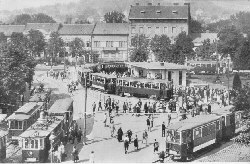
The junction of Retek Utca and Krisztina Körút in the 1930’s. At weekends,
the Budapest citizen would go on excursions. They would go to the stop
at Retek Utca and catch an 83 (with trailer) to Hüvösvölgy, or an 81 (Single
unit) to Zugliget (If they could fit on) |
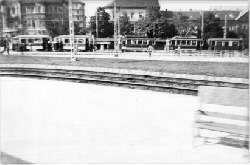
During the war, all available tramcars were pressed into service. The
petrol-powered trams (railcars) to the right of the picture were pushed
into service after being adapted as trailers. These trams ended up in Szombathely,
on its 1000mm gauge tramway.
|
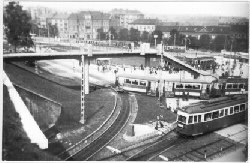
The 3600 trams (‘Stuka’s) were delivered during the war. These trams
were similar in both bodywork and mechanical capabilities to the UV types,
but were only run as single units or with a trailer. One of these trams
can be seen on the right of the picture.
|
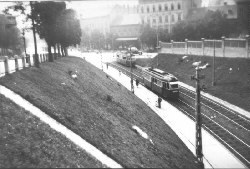
3600 series trams on the tunnel incline, probably in the 40’s
|
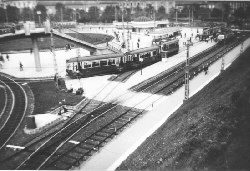
This picture from the end of the 40’s shows one of the then recently
delivered 5800 series trailers being pulled by a 1000 series Motor unit
on route 6
|
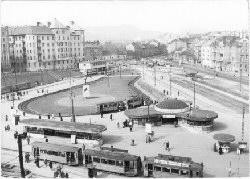
A no. 6 tram is just starting off at the bottom of this photo from the
50’s. A four-wheel Motor unit is towing two ‘Gy?ri’ trailers. These trailers
were acquired during and after the war, but are still operational today,
after fitment with sliding powered doors as trailers to UV type motor units,
the trailers being in the 5800-5900 series.
|
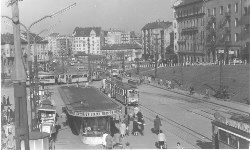
UV types were introduced to route 6 in the 50’s, though at first only
as two-car units. One of these units has just reached Széna Tér. A manual
point-handle can also be seen; the points, due to their railway traffic
were set with joists under the pavement.
|
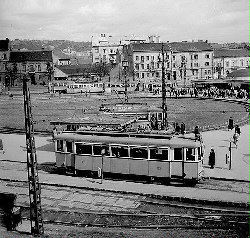
A sunny sunday morning in 1957
|
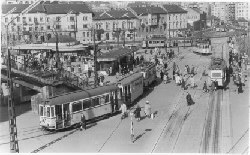
The straight passing-through tracks are interesting, in that, due to
their use for railway traffic, the tracks are of the wider flange variety,
as is neccesary for main-line use. This is apparent today as well, between
Déli Pályaudvar and Moszkva Tér and between Széna Tér and Kisrókusz utca.
|
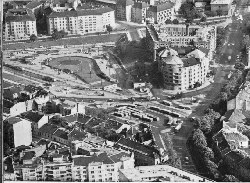
In this picture from the 1960’s, 22 trams and 19 buses are present.
|
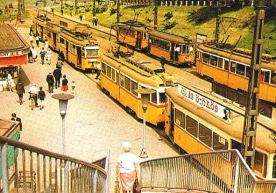
At first, UV types ran as two-car units, but after extensive tests with
trailers, the three-car units were introduced to route 6. However, as the
conversion of the trailers was being done as quickly as possible, only
the most neccesary items of equipment were fitted to them to start with.
For instance, powered, cab-operated doors were not fitted to many such
cars, the reason why the doors on the nearest Unit’s trailer are open.
|
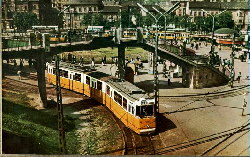
This tram is the experimental version of the Ganz ‘Ipari’ type, which
worked route 44 in the 60’s. The 44 route ran from Moszkva Tér to Zugló,
Rákospatak. The experimental car differed from the production cars with
its swept back windscreen and smaller windows on the doors.
|
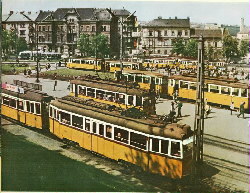
The UV and 1000 series trams, which are described in greater detail
on our web site, are visible on this picture. The last 1000 types spent
their last years on routes 56,58 and 59 as these cars were uniquely fitted
with equipment for hilly routes. For example, they were fitted with an
anti-rollback system, which prevented the car from rolling away when no
brakes were applied, ie. when the driver left the cab.
|

In the 60’s, the Bus station was on the site of where todays sidings
are. On the buses at this time, seated conductors were used, therefore
passengers were only allowed to board through the
rear set of doors, where the conductor was.
|
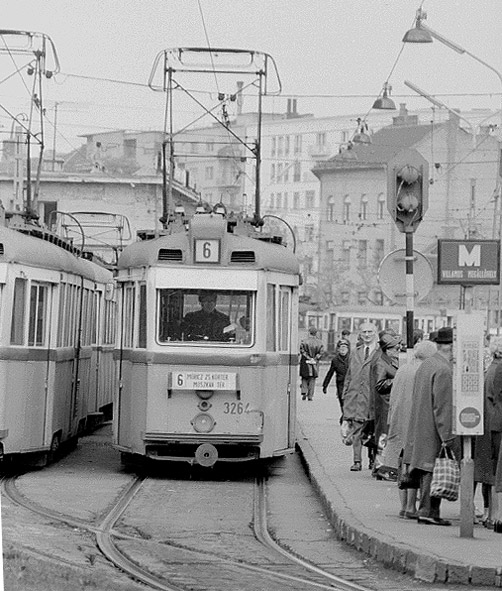
At the terminal point for routes 4 and 6, between the boarding/alighting
area, two sidings were available, alongside Várfok utca. The sidings alongside
the embankment wall, though rarely used, still exist, also being used for
overtaking purposes.
|

Until the GANZ factory moved from it’s Margit Körút premises, the square
carried considerable goods traffic.
|
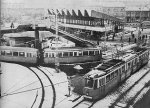
By 1972 the Metró Station building had been completed. Because of this,
the turning circle for the Hüvösvölgy routes (56 and 58) had to be rebuilt
to a tighter format.
|
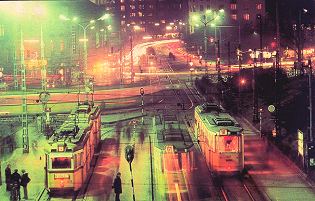
UV types served the Nagykörút (Grand Boulevard) until 1972, after which
came coupled Ganz ‘Ipari’ sets. On the picture, a number 4 has got a start
signal, meaning the 18 about to turn has to wait.
|
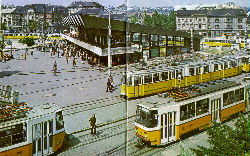
TATRA T5C5 trams arrived in the 80’s and one of their first routes was
the 59, but soon after they were also placed into service on routes 18
and 61
|
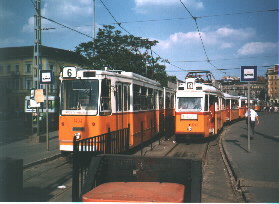
In 1990 the square was changed, the complex of points and turning circles
for both Körút and Mid-Buda routes were removed. At the new terminus for
routes 4 and 6 stand a ‘normal’ number 6 and one of a more vintage variety
|